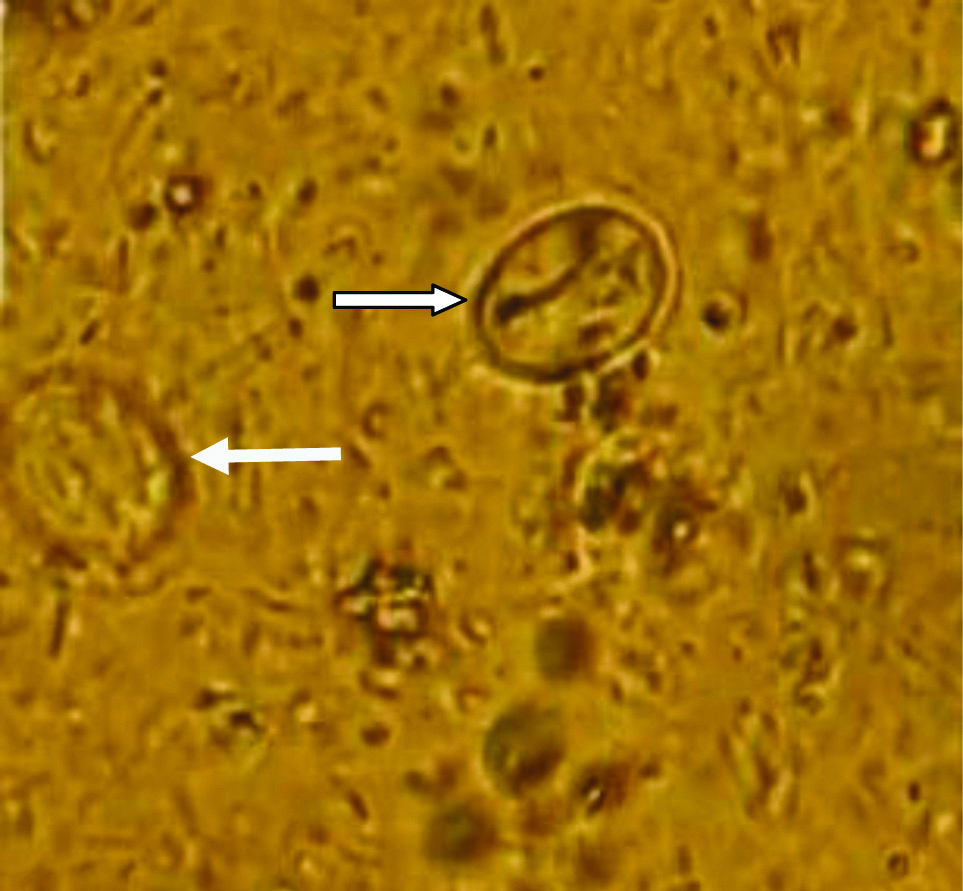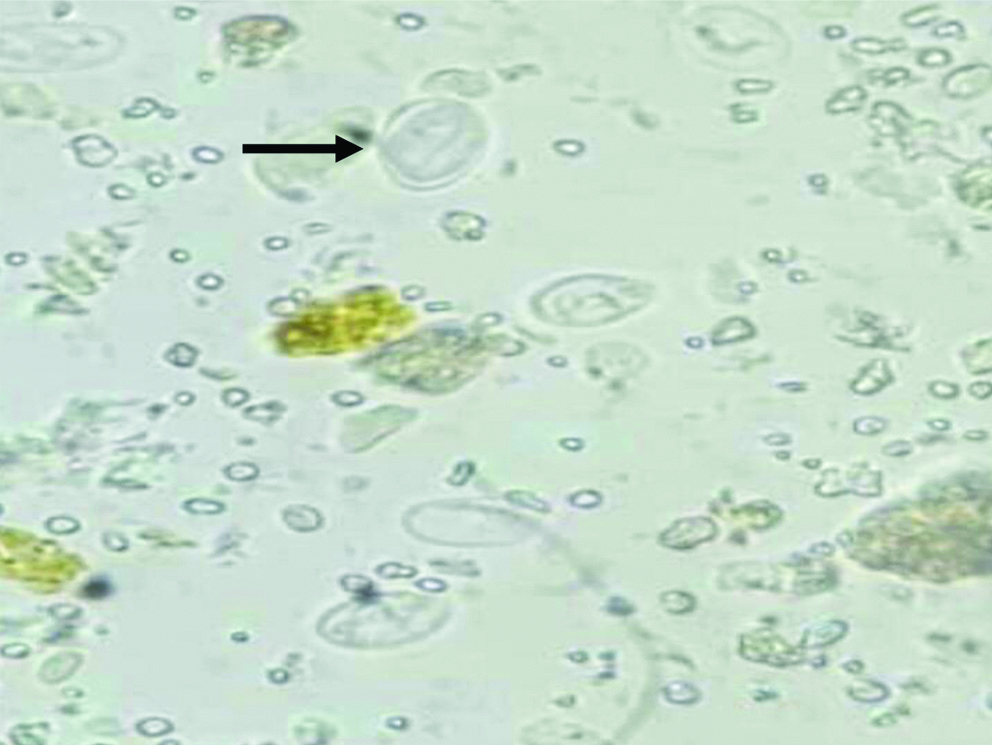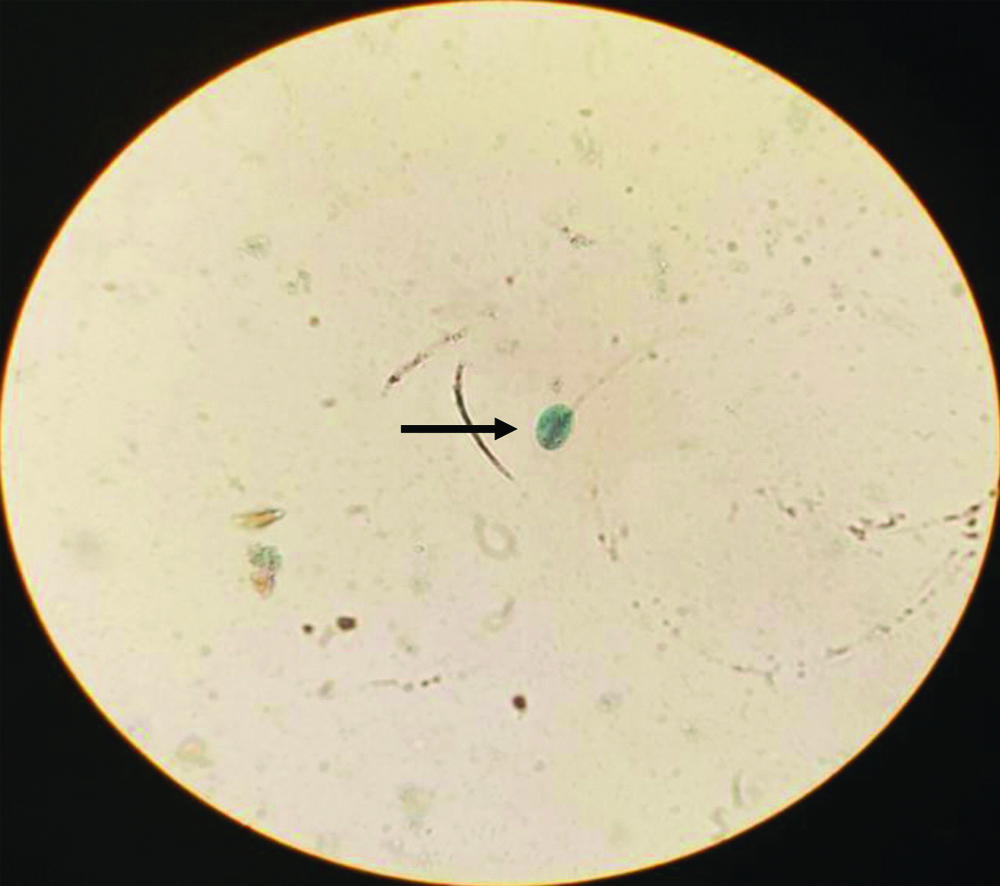Giardiasis can be asymptomatic or even symptomatic, clinical symptoms are very diverse which includes weakness, weight loss, watery diarrhea, stinky stools, fatty diarrhoea, abdominal cramps and bloating, nausea, vomiting, and malabsorption syndrome [1,5,10-12]. Since most asymptomatic patients excrete cysts through their feces, the detection of cysts using microscopic examination is the best way to identify these patients [6,9,12]. The disease is transmitted through contaminated water with cysts, that are very resistant to chlorine in water [4,11,13]. A remarkable point about giardiasis is its higher occurrence in children, than other age groups, which can be due to the low hygienic conditions among children [4,5,8]. Drinking water disinfection along with treating patients (whether symptomatic or asymptomatic) is one of the best ways to prevent this disease [3-5].
Various factors such as age, gender, and environmental conditions play key roles in the occurrence of giardiasis, and even its prevalence. Giardiasis is still one of the most common causes of parasitic disease in Iran, despite the numerous studies on its prevalence, and despite decreasing in the parasitic infection’s prevalence. According to a national study, the highest rate of giardiasis infection was in Hamadan province (39.58), and the lowest was in Isfahan province (1.48) [4].
Therefore, studying the prevalence of giardiasis, its digestive disorders, and its risk factors can immensely benefit the community’s general sanitation condition, as well as increasing the awareness of the causes of environmental contamination and its respective prevalence rates. Ilam is a major hotbed for the spread of this parasite due to its special geographic location and its climate condition. So, most people are familiar with the name of Giardia. The present study, thus, aimed to investigate the prevalence of Giardia infection in people referred to labs in the city of Ilam, Iran in 2017.
Materials and Methods
Study Population
This present descriptive cross-sectional study was performed in April 2017 to October 2017 on 1000 random stool samples of patients referred to five laboratories in Ilam; the Health Center of Ilam, Central Laboratory of Ilam, Saboor Medical Laboratory, Ghaem Hospital Lab, and Imam Hospital Lab. Listed laboratories were among the most important and largest in the province, and people are referred to them from different parts, both from urban and rural areas.
Out of the total, 638 (63.8%) were males and 362 (36.2%) were females; ranging from 4 to 80 years of age. The participant’s consent was obtained before sampling, and the Ethics Committee of the Medical University of Ilam approved the study (Code: 968038/124).
Collection and Processing of Specimens
Stool samples from each patient were collected into a clean wide- mouthed container labeled with individual’s characteristics.
Demographic details (age, gender, and living location), and clinical symptoms (including no symptoms, diarrhea, weight loss, flatulence, and stomach ache) were collected. All specimens were stored in formalin 5% (four gram of stool was added in 5 mL formalin, 5%) and transferred to the parasitological laboratory for testing subsequently. The samples were examined microscopically for ovalocyst, cyst, and trophozoite of parasites using saline and iodine mount on grease-free slides. Wet mount process was done according to common standard protocol [14]. The identification was based on the unique morphology of Giardia cyst. Following this, suspect specimens were confirmed by using Trichrome staining [15,16].
Statistical Analysis
Data were analysed using Statistical Program for Social Sciences (SPSS) (20.0 version) software, and the frequency of data were compared using the Chi-square (χ2) test. Values were significant at p<0.05.
Results
According to the statistical analysis, there was a significant relationship between age and infectivity rate of Giardia lamblia (p≤0.05). The maximum age for giardiasis infection was 50 years and, the minimum was four-year-old. Participants aged 20-30 years had the highest level of infection (48.8%), which demonstrates a significant difference in comparison with other age groups (p<0.05). Moreover, the lowest levels of infection were observed in the age group 13-19 years [Table/Fig-1].
Frequency of giardiasis by age groups.
| Frequency | Range-age (years) | Total | p-value |
|---|
| 0-12 | 13-19 | 20-30 | 31-50 | 51-75 | +75 |
|---|
| Giardia positive (%) | 12 (14.28) | 8 (9.52) | 41 (48.8) | 23 (27.38) | 0 (00.0) | 0 (00.0) | 84 (100.0) | 0.049 |
The results of this study showed, out of 1,000 people, 84 (8.4%) were infected with Giardia and 916 (91.6%) were reported to be healthy or infected with other parasites [Table/Fig-2,3,4 and 5]. The percentages of male and female infected with giardiasis were 56 (66.67%) and 28 (33.33%), respectively [Table/Fig-6]. Furthermore, Giardiasis was seen among rural areas (64.28%) more than urban ones (35.71%) [Table/Fig-7].
Frequency prevalence of giardiasis.
| Parasite name | Frequency | Percent | Cumulative percent |
|---|
| Not seen | 785 | 78.5 | 78.5 |
| Entamoeba coli | 45 | 4.5 | 83.0 |
| Blastocystis | 81 | 8.1 | 91.1 |
| Enterobius vermicularis | 3 | 0.3 | 91.4 |
| Entamoeba histolytica | 2 | 0.2 | 91.6 |
| Giardia | 84 | 8.4 | 100.0 |
| Total | 1000 | 100.0 | |
Giardia lamblia in stool exam (x100), iodine mount.

Giardia lamblia in stool exam (x100), saline mount.

Giardia lamblia in stool exam (x100), trichrome staining.

Frequency of giardiasis by gender.
| Frequency | Sex | Total | p-value |
|---|
| Female | Male |
|---|
| Giardia positive (%) | 28 (33.33) | 56 (66.67) | 84 (100) | 0.636 |
Frequency of giardiasis based on place.
| Frequency | Place | Total | p-value |
|---|
| City | Village |
|---|
| Giardia positive (%) | 30 (35.71) | 54 (64.28) | 84 (100.0) | 0.001 |
Out of 84 infected samples with giardiasis, there were 34 asymptomatic and 50 symptomatic. Clinical symptoms between all infected patients with giardiasis by age groups were 3.1% stomach ache, 2.8% bloating, 1.6% diarrhea and 0.8% weight loss, respectively [Table/Fig-8].
Frequency of clinical symptoms in patients with giardiasis by age group.
| Age group (years) | Diarrhea | Weight loss | Flatulence | Stomach ache |
|---|
| 0-12 | 6 (0.6%) | 0 (00.0) | 6 (0.6%) | 6 (0.6%) |
| 13-19 | 0 (00.0) | 0 (00.0) | 6 (0.6%) | 6 (0.6%) |
| 20-30 | 10 (1%) | 8 (0.8%) | 12 (1.2%) | 10 (1%) |
| 31-50 | 0 (00.0) | 0 (00.0) | 4 (0.4%) | 9 (0.9%) |
| 51-75 | 0 (00.0) | 0 (00.0) | 0 (00.0) | 0 (00.0) |
| 75+ | 0 (00.0) | 0 (00.0) | 0 (00.0) | 0 (00.0) |
| Total | 16 (1.6%) | 8 (0.8%) | 28 (2.8%) | 31 (3.1%) |
| p-value | 0.072 | 0.113 | 0.232 | 0.009 |
Discussion
In the present study, the prevalence of giardiasis in Ilam was calculated as 8.4%, while a study by Talebimeymand F et al., reported 43% of the giardiasis prevalence in the same area [17]. Furthermore, in another study conducted by Abdi J et al., the prevalence of this parasite was 11.7% [18]. By comparing these, we can see a significant reduction of infection in Ilam.
There are numerous studies on the prevalence of Giardiasis in different parts of the country [Table/Fig-9] [5,19-27]. Studies show the highest prevalence in the year 2015 and the lowest in 2014 [5,23]. There are fluctuations in the prevalence of giardiasis in different parts of Iran. It is related to earth heating, the population increasing, time and location as well as the improvement in the health policies [4]. Overall, it seems that the prevalence of giardiasis has decreased compared to previous years; it could be because of increasing public awareness and compliance with health principles.
Prevalence of Giardia lamblia in different parts of Iran.
| Authors [References] | Year (Study conducted) | City or province | Study population | The prevalence of Giardia lamblia (%) |
|---|
| Gharavi M et al., [19] | 2011 | Tehran | Patients referred to the laboratory | 10.8 |
| Rostami M et al., [20] | 2012 | Gorgan | Elementary students | 9.9 |
| Elmi T et al., [21] | 2013 | Karaj | Patients referred to the laboratory | 10.1 |
| Mahni MB et al., [22] | 2013-2014 | Kerman | Rural and urban people | 7.8 |
| Norouzi R and Manochehri A [23] | 2014 | Sanandaj | Different age groups | 3 |
| Faraji R et al., [5] | 2015 | Kermanshah | Kindergarten children | 13.93 |
| Rahimi H et al., [24] | 2015 | Shahroud | Kindergarten children | 7.4 |
| Rezaee E et al., [25] | 2017 | Gerash | Individuals Referred to Amir Almomenin Hospital | 10.5 |
| Mahmoudvand H et al., [26] | 2016-2017 | Lorestan | Children 2-15 years old | 5.5 |
| Salemi B et al., [27] | 2018 | Tehran | Working children | 9.1 |
In the study performed by Faraji R et al., in Kermanshah, the prevalence rate of Giardia was recorded at 13.9% [5]. The difference between the study carried out in Kermanshah and the present study can be attributed to the discrepancies in the weather conditions or socioeconomic circumstances of the two regions.
According to the results of this study, the symptoms of giardiasis were more in the individuals aged 20-30 years and, in the males, more than the females. In this study, the most common signs were abdominal pain (3.1%), and weight loss (0.8%), claimed the lowest prevalence. The results of the present study, bear some resemblance to other studies while revealing a number of differences as well [21,28,29].
Contrary to the present study, in a study conducted in Karaj in 2013 by Elmi T et al., it was found that most people were symptomatic, and the most common symptom was nausea [21]. However, another study conducted in Kerman in 2011, found abdominal pain to be the most common symptom, which is consistent with the findings of the present study [28]. Diarrhoea is one of the common symptoms associated with this parasite; in some studies, between 64% to 100% of people had this symptom [28,29]. Nonetheless, only 1.6% of the affected individuals surveyed in this study reported this sign. It seems to be related with the status of the immune system and the pathogenicity of the parasite [28,29].
By comparing this study results to other studies, it can be concluded that symptoms of gastrointestinal disorders associated with giardiasis are different, which depends on the different geographic regions.
The study of Bernawi A et al., indicated that the higher rate of infection was observed in males (5.26%), compared to females (1.71%), and such findings correspond to the results of the current study [30]. In contrast, in a study conducted in Baghdad, the rate of infection among females was 2.18% (in males it was 1.51%) [31].
In a study by Faraji R et al., on kindergarten children in Kermanshah, the giardiasis prevalence was more in villages than in towns same as the current study [5]. In the present study, the level of giardiasis among rural and urban residents were (64.28%) and (35.71%), respectively.
As mentioned above, the highest infection rate (48.8%) was in the age group of 20-30-year-old, which was significantly higher than the other age groups. There seem to be other reasons beyond these common known. It is an important and rare finding. The high level of infection in this age group, and especially among those living in villages, seems to be mainly due to several reasons, including direct contact among people, the employment of the villagers in agriculture and animal husbandry, as well as their further contact with agricultural soils and contaminated soils, the use of non-drinkable water, the use of human fertilisers to strengthen agricultural land, etc.
The prevalence of giardiasis in the Ilam province is due to different factors, including geographical, climatic and cultural conditions, deprivation of nutrition due to economic poverty, the increasing population, lack of proper drinking water and inappropriate sewage facilities [17]. They need to be addressed seriously by planning such as collecting sewage properly, avoiding the use of human fertilisers and non-drinking water, protecting drinking water sources against pollution, observing personal and public hygiene by residents.
Limitation(s)
Because of lack of access to certain information, authors were not able to investigate some risk factors such as occupation, income level, and contact with animals. Furthermore, there was no assess to important information related to the clinincal features to rule out other reasons for the gastro-intestinal sysmptoms due for lack of access to complete clinical characteristics relationship between giardiasis with gastrointestinal symptoms.
Conclusion(s)
In spite of the decreasing prevalence of parasitic infections due to the health level promotion, giardiasis is still one of the most common intestinal protozoa in Ilam. This parasite is the main cause of gastrointestinal disorders. Therefore, it is crucial for recognising its risk factors.